How To Set Up Paid Advertising On A Blog
Social media advertising is a must if you're looking to reach a new, targeted audience—fast.
Like it or not, organic reach is harder and harder to achieve. The days of going viral without a little boost might be gone forever.
Of course it can be scary to move from an organic social strategy to putting real money on the table. So, it's important to understand all the options.
In this guide, we explain how to use the various types of social media ads to achieve real business results while maximizing your spend.
Bonus: Download a free guide that teaches you how to turn Facebook traffic into sales in four simple steps using Hootsuite.
Advertising on social is a hyper-direct way to reach the audience you want. You can target brand new customers or returning ones. (New friends! Hooray!) It's also a chance to do some hands-on A/B testing.
All the major social networks offer advertising options. That doesn't mean you should use all of them.
When choosing where to place your ads, it's also helpful to know which networks are most popular with your target audience. Where is your target group most engaged, most concentrated and most accessible?
Targeting teens? TikTok is where to find them. Moms, meanwhile, love Facebook.
Try looking at which social networks perform well organically for your brand. Where does your content naturally strike a chord with fans? This is an obvious choice for your first social ad campaigns.
Here's a quick summary from the Pew Research Center's most recent social media fact sheet. It shows a great snapshot of the preferred platform of different demographics.

Source: Pew Research Center
Now that you have a sense of which social networks might be best for your business, let's take a look at each network's ad types.
Facebook ads
Facebook ads help you achieve one of three broad types of campaign objectives:
- Awareness: Build brand awareness or increase reach.
- Consideration: Send traffic to your website, increase engagement, encourage app installs or video views, generate leads, or encourage people to communicate with you on Facebook Messenger.
- Conversion: Increase purchases or leads via your site or app, make cata, or drive foot traffic to offline stores.
Audience considerations: Facebook is popular across many demographics, with 2.45 billion monthly active users. Just as many teenagers use Facebook as their parents—and seniors are quickly catching up.
With detailed targeting options for this huge pool of users, Facebook is a great platform to get started with social media advertising.
With ads, you can direct users to your Facebook Page or your website. You can also direct them to a customized Instant Experience. This is a full-screen interactive or informational destination page within the Facebook mobile app.
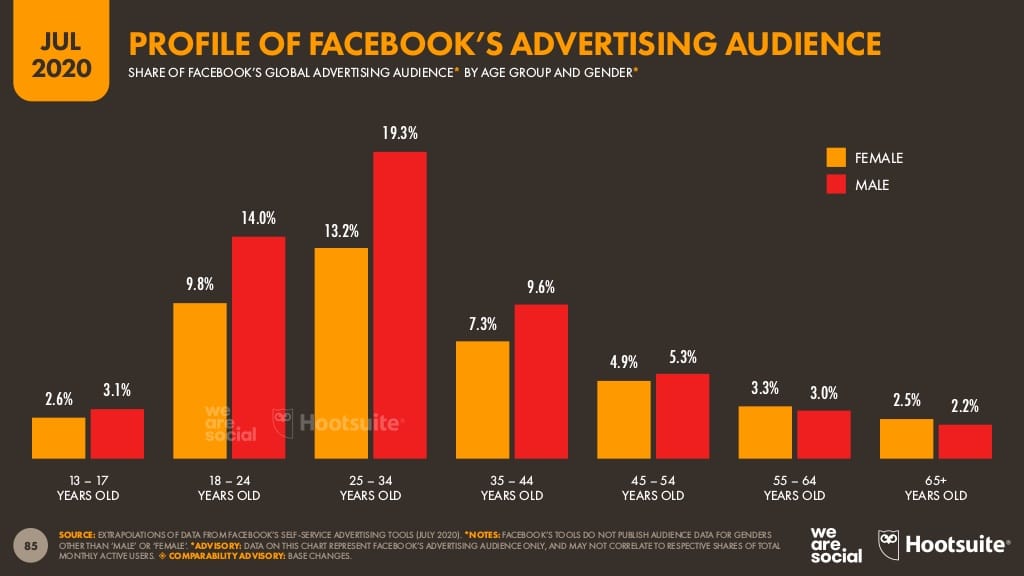
Source: Hootsuite Digital 2020 Report
Photo ads
Facebook's internal data shows that a series of photo-only ads can drive more unique traffic than other types of ad formats.
In addition to a photo, Facebook photo ads include 90 characters of text plus a 25-character headline. Show and tell! These ads can also include a call-to-action button like Shop Now or Download.
You can create your photo ad in Facebook Business Manager, or simply promote a post with an image from your Facebook Page.
Pro tip: If you've got a tangible product, a Facebook photo ad is a great way to show it off. Show people using your product, rather than a simple photo of the product itself.

Video ads
Facebook video ad options range from short, looping video clips that autoplay in users' feeds, to original 241-minute promoted videos for the desktop. You can also develop video ads that play within other videos (Facebook video ad Inception!), or even share 360-degree videos.
With so many options, it's critical to have solid goals and understand who your target market is and where your video will reach them.
Pro tip: Short videos tend to have higher completion rates. However, if you've got a compelling message, you can go a little longer. Video can help clearly demonstrate your services—like a cool dance class—and stand-out in a mostly static news feed.
"Had me sweating and smiling at the same time"💯 Beginner & Advanced Classes🔥 7-day FREE TRIAL 🔥
Posted by The Underground Dance Centre on Monday, June 15, 2020
Stories ads
In this full-screen format, photos display for six seconds, and videos can last up to 15 seconds.
One hiccup: You can't specifically select Facebook Stories ads on their own. They're included as a possible placement when you select Automatic Placements when creating your ad for the News Feed or Instagram Stories campaigns.
Pro tip: Stories only last for 24 hours, so this is a great format for in-the-moment marketing like limited time offers. The majority of people Facebook surveyed said they wanted Stories ads to be "quick and easy to understand." Keep things simple.

Source: Facebook
Carousel ads
No whimsical horses on this kind of carousel. A Facebook carousel ad lets you include up to 10 images or videos, each with their own link, all in one ad.
Carousel ads work well to showcase different features of a product, or to explain a step-by-step process. They're also a great way to present multiple products or services. For example, a Gap polo or a Gap t-shirt.
Pro tip: Use the different elements in your carousel ad together to present a compelling, effective story or message. (That being said: if you need them to stay in a certain order, opt out of the automatic optimization feature.)

Source: Facebook
Slideshow ads
A slideshow is an ad that creates a video from several static images—your own or stock images that Facebook provides.
Slideshows offer the compelling motion of video, but require no video-specific resources to create. The best of both worlds! If you're not ready to try video ads but want to move beyond static photos, slideshow ads are a great option. Plus: fun music!
Pro tip: If you don't have professional photography on hand, stock photos can be a great option to help you express your brand's vibe.

Source: Facebook
Collection ads
A collection ad highlights your products right in the Facebook feed. The ad includes a cover photo or video, plus four smaller product images with pricing and other details.
Think of it as your digital storefront, or an instant peek into your catalog. This format allows people to learn more about your product without leaving Facebook.
Pro tip: Collection ads work especially well for retail and travel brands.

Source: Facebook
Messenger ads
Messenger ads are simply Facebook ads placed in the Chats tab of the Messenger app. They'll appear between conversations.
You can use them to start an automated conversation with a potential customer right there on Messenger, or link out to your website to your website or app.
Over 1.3 billion people use Messenger every month—many of whom aren't even Facebook users. Get chatting.
Pro tip: You can use Messenger ads to restart conversations that have trailed off. Use a custom audience of people who have previously messaged your business.
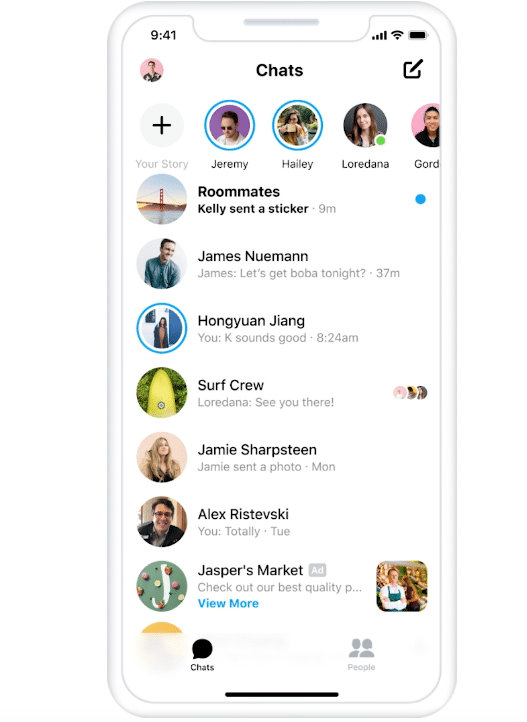
Source: Facebook
Playable ads
Facebook Playables are mobile-only interactive previews of your game or apps. This offers an opportunity for users to try before they buy (or download).
These ads start with a lead-in video prompting people to play, via a "tap to try" icon. From here, users can click and instantly test-drive a full-screen demo version, without having to install anything.
It's a great way to showcase your game, with a low barrier to entry for someone scrolling by.
Pro tip: Make sure you accurately represent the game in your lead-in video, and keep your tutorial simple: as little as two steps, ideally.
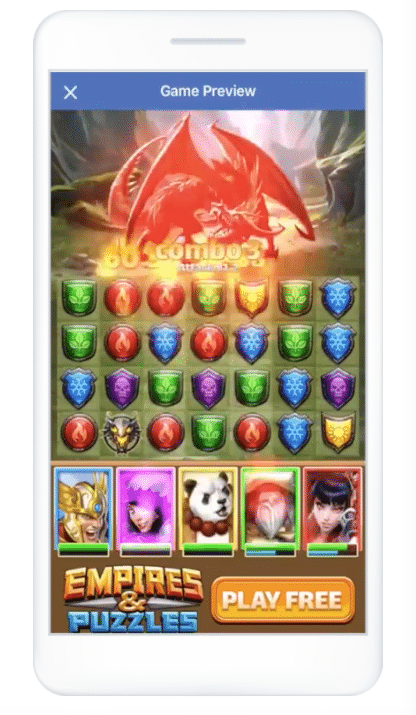
Source: Facebook
Get all the step-by-step instructions you need to set up your Facebook ads in our Facebook advertising guide.
Instagram ads
Facebook owns Instagram. So it's not surprising that Instagram ads support the same three broad categories of campaign objectives as Facebook ads:
- Awareness
- Consideration
- Conversion
Audience considerations: Instagram is most popular with millennials. Plenty of Generation Z and Gen Xers also use the platform.
Like Facebook, you can target your ideal viewer with custom targeting options. Create lookalike audiences, define your audience's behaviors and activities, interests, and demographics.

Source: Hootsuite Digital 2020 Report
The specific Instagram ad types also mirror four of the Facebook ads types:
- Photo
- Video
- Carousel
- Collection
You can create each type of ad for either the main Instagram feed, for Instagram Stories. Placing ads on IG TV offers a unique ways to reach your audience, too.
Instagram Reels are a new content format for the platform, but so far, there are no paid advertising opportunities here. That being said: the novelty of Reels could make it a great opportunity to experiment with organic reach. Get in on the ground floor, and tell your grandkids you were there when it all began.
Photo and video ads
Your Instagram photo or video will look like a regular Instagram post—except that it will say Sponsored in the top right. Depending on your campaign objective, you may also be able to add a call-to-action button.
Pro tip: Make sure your photo and video ads are consistent in style with the organic posts you share on Instagram. This helps viewers recognize that the ad is from your brand.

Source: Instagram
Carousel ads
In an Instagram carousel ad, viewers swipe to scroll through different images.
Pro tip: Make sure the images you use in your carousel ad are visually similar and tied together by a common theme. It shouldn't be jarring to swipe between the different photos in the ad.
Look at this Carousel ad for Shutterstock. (Does it make you hungry? Sorry.) The similar images and consistent bar of text across each photo clearly connect the components of the ad and help to tell a consistent story.

Source: Instagram
Collection ads
Just like Facebook Collection ads, these feature a cover image or video plus several product shots. Clicking on the ad directs the user to an Instant Experience.
It's the perfect fit for a retail brand. Show 'em what you've got!
Pro tip: Instagram Collection ads don't include a headline, but they do allow up to 90 characters of text.

Source: Instagram
Ads in Explore
Extend your ads into the Explore feed and reach an audience who is looking to for new and novel accounts to follow.
It's a way to place yourself next to the content that's relevant and trending—and catch the eye of the 200 million-plus users who check out the Instagram Explore tab daily. (They're brave explorers, out looking for new adventure on the Instagram frontier, and we salute them.)
Pro tip: Your ad won't appear in the Explore grid directly, but when a user clicks through on any photo, they'll see your post in the scrolling news feed.

Source: Instagram
Instagram Stories ads
Instagram Stories ads can use photos or videos up to 120 seconds long. These ads display in full-screen format between people's stories.
Pro tip: Add interactive elements to Story ads for the best performance.
Dunkin' found in an A/B test that a Story ad with a poll sticker had a 20% lower cost per video view. Plus, 20% of people who watched the video voted in the poll. (On the very important topic of which is better: donuts or fries.)
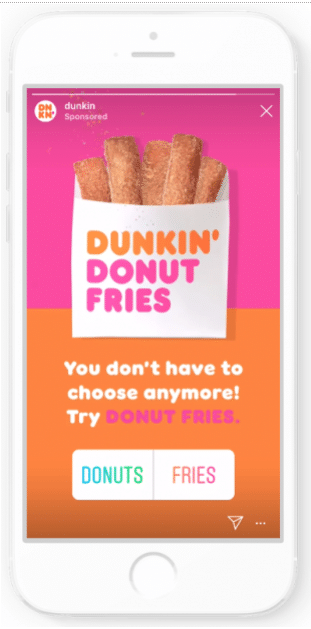
Source: Instagram
IGTV advertising
Users can post longform videos on a platform-within-a-platform called IGTV. This feature was introduced on Instagram back in 2018, and as of June 2020, you may now place advertising within user-created videos.
IGTV video ads will only appear once a user has clicked over to IGTV from their feed. Ads need to be vertical (mobile optimized) and can be up to 15 seconds long.
Pro tip: This feature is only available with certain Instagram accounts at this point, so you might be limited to working with content from influencers, rather than big-name media companies.
Source: Instagram
Get all the step-by-step instructions you need to set up your Instagram ads in our Instagram advertising guide.
Twitter ads
Twitter ads work towards three different business objectives:
- Awareness: Maximize the reach of your ad.
- Consideration: Whether you want video views, pre-roll views, app installs, web traffic, engagement or followers, this is your category.
- Conversion: Bring users to your app or website to take action.
Audience considerations: Nearly two-thirds of Twitter's advertising addressable audience is male.

Source: Hootsuite Digital 2020 Report
Twitter offers two ways for brands to create Twitter ads:
- Twitter Promote automatically promotes Tweets for you. (Note: this service is no longer available to new users.)
- Twitter Ads campaigns allow you to set up campaigns yourself based on your marketing objective.
Twitter Promote
With Twitter Promote, the Twitter algorithm automatically promotes Tweets to your specified audience. It promotes your first 10 daily organic Tweets that pass the Twitter quality filter. It also promotes your account to attract new followers.
You can focus on up to five interests or metro locations, and let Twitter do the rest. Unfortunately, with this feature, you can't choose which Tweets to promote. (But maybe that's part of the thrill?)
Pro tip: Twitter Promote mode costs $99 USD per month. Twitter says accounts will on average reach 30,000 additional people per month and gain an average of 30 new followers.

Source: Twitter
Twitter ad campaigns
With Twitter ad campaigns, you first choose a business objective that aligns with your business goals.
For example, this Ritz Crackers ad uses a video to showcase its product, combined with a link to easily… learn more about crackers.

Source: Twitter
You can select existing organic Tweets to promote, or create Tweets specifically as ads.
Pro tip: Run separate campaigns for mobile and desktop users to get the best conversion rates. Twitter recommends you avoid using hashtags and @ mentions in your ads. (These may cause your audience to click away.)
Get all the step-by-step instructions you need to set up your Twitter ads in our Twitter advertising guide.
Snapchat ads
Snapchat ads can help you achieve three types of marketing objectives:
- Awareness: Reach a large audience to increase awareness of your brand and showcase products and services
- Consideration: Drive traffic to your website or app, increase engagement, and encourage app installs, video views, and lead generation.
- Conversions: Drive website conversions or catalog sales.
The Instant Create service is a simplified way to get your image or video ad up in under five minutes. If you've got a simple advertising goal—for example, getting a Snapchatter to call up your pizza parlor—this is a quick and easy way to get started.
For more in-depth advertising goals, there's Advanced Create. This is for advertisers who have more long-term or specific objectives and might need more control over budgets, bids, or optimization.
Audience considerations: Snapchat is overwhelmingly popular with younger users, with 220 million users under the age of 25. Nearly three-quarters of 18- to 24-years olds use the app. Compare that to only 25% of 30- to 49-year-olds. About 60% of the audience you can reach with Snapchat ads is female.

Source: Hootsuite Digital 2020 Report
Snapchat offers six types of ads to help you meet your objectives.
Snap ads
Snap ads start with an image or a video up to three minutes long (though Snapchat recommends keeping things short and sweet at 3 to 5 seconds).
The ads are full-screen, vertical format. These appear between or after other content. They can include attachments for app installs, landing pages, lead forms, or long-form video.

Source: Snapchat
Pro tip: Don't try to do too much with a short ad: Feature one strong call-to-action and key message. Try experimenting with different forms, like gifs or cinemagraphs, and see what really catches people's attention.
Story ads
This ad format takes the form of a branded tile in users' Discover feed. The tile leads to a collection of three to 20 Snaps, so you can provide a detailed look at new products, special offers, and so on.
You can also add attachments with a call-to-action, so that users can swipe up to watch a video, install an app, or buy a product.
Pro tip: Write a powerful headline for your Story ad to encourage Snapchatters to tap.

Source: Snapchat
Collection ads
Collection ads allow you to showcase a series of products with four thumbnail images in one ad. Each thumbnail image links to its own URL. Snapchatters can also swipe up to see your website.
Pro tip: Keep the snap itself simple to focus attention on the thumbnails in your collection ad.

Source: Snapchat
Filters
Snapchat filters are graphic overlays that users can apply to their Snaps. Snapchatters use them hundreds of millions of times per day.
You can make your filter "smart," so it includes real-time location, countdown, or time information.
Pro tip: Snapchatters use filters to provide context to their Snaps. Make sure your filter is relevant to the time, place, and purpose of your campaign. Leave room for Snapchatters' own images to shine. Only use the top and/or bottom quarters of the screen for your filter creative.

Source: Snapchat
Lenses
Similar to Filters, Lenses are a way to layer your brand on to a user's content. Lenses are a little more high-tech, however, using augmented reality for a more interactive visual effect.
Bonus: Download a free guide that teaches you how to turn Facebook traffic into sales in four simple steps using Hootsuite.
Get the free guide right now!
Face lenses, for example, can manipulate a user's facial features on-screen to transform them. Using a branded Snapchat lens, a makeup fan could try a digital makeover, or become Colonel Saunders.
World lenses work on the outward facing camera. These can map images onto the environment or surfaces around you—and find yourself seeing just how that Ikea couch would look in your living room.
Pro tip: A cool lens is great; a shareable lens is better. Think about creating a visual experience that's either beautiful or funny, to give your users a reason to share their video with friends… and tempt them to try for themselves. Like this sweet LOL Doll lens.

Source: Snapchat
Get all the step-by-step instructions you need to set up your Snapchat ads in our Snapchat advertising guide.
Commercials
In certain regions, Snapchat Commercials are another advertising option. These are non-skippable six-second video ads, and must be videos with audio.
Pro tip: Focus on one simple message, ideally with a reveal or payoff at the five second mark to build a little suspense. Make sure your branding is crystal clear.
LinkedIn ads
LinkedIn ads help your business with three types of marketing objectives:
- Awareness: Create more awareness of your company or brand.
- Consideration: Drive website visits, increase engagement, or encourage video views.
- Conversions: Collect leads and drive website conversions.
Audience considerations: LinkedIn is much more business-oriented than the other social networks in this post. It offers targeting options based on professional qualifications like job title and seniority.
Let's get down to business.

Source: Hootsuite Digital 2020 Report
You can choose from several different types of LinkedIn ads.
Sponsored Content
Sponsored Content ads appear in the news feed on both desktop and mobile. They're used to get your content in front of a larger audience and showcase your brand expertise.
Single images, videos, or carousel ads are all different options for sponsored content advertising on LinkedIn.
Pro tip: Headlines under 150 characters have the best engagement. Larger images get higher click-through rates. LinkedIn recommends an image size of 1200 x 627 pixels. Make sure your CTA is loud and clear.

Source: LinkedIn
Sponsored InMail
Sponsored InMail is similar to email marketing, except that the messages go directly to users' LinkedIn inboxes. Like a pen pal! That you pay for.
However, Sponsored InMail has an interesting unique feature. Users only receive ad messages while they are active on LinkedIn. That means messages don't sit around getting stale.
You can send a direct message to your audience, or create a more conversational experience—sort of a choose-your-own-adventure, super simple chat bot.
Pro tip: Short body text (under 500 characters) gets the highest click-through rate. But the sender plays a role too in setting you up for success. Ask yourself: who would my audience connect with?
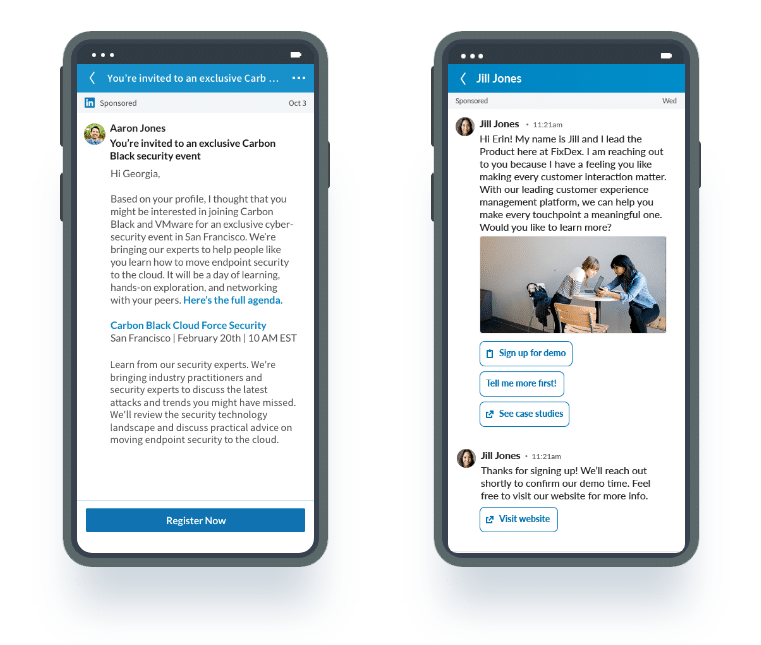
Source: LinkedIn
Text Ads
Text ads are small ad units that appear at the top and the right of the LinkedIn news feed. They only appear to desktop users, not on mobile devices.
Despite the name, text ads can actually include a thumbnail image of 50 x 50 pixels.
Pro tip: Create two to three variations of your campaign, both for A/B testing but also to show your many sides to your audience.

Source: LinkedIn
Dynamic ads
Dynamic ads are automatically personalized specifically for each of your prospects. It's either AI or magic at work.
Don't be afraid to get personal! You can target users personally and directly to encourage them to follow you, read your thought leadership articles, apply for your jobs, or download content.
Pro tip: Enable your target audience's profile photo to be featured in their own personal ad, to visually personalize the campaign. You can also pre-set templates with macros to feature every target's name and company in the text.

Source: LinkedIn
Get all the step-by-step instructions you need to set up your LinkedIn ads in our LinkedIn advertising guide.
Pinterest ads
Pinterest ads work with six types of business goals:
- Build brand awareness
- Drive traffic to your website
- Drive app installs
- Drive traffic to specific products
- Encourage specific actions on your website
- Drive video impressions
Audience considerations: Pinterest has significantly more female users than males.

Source: Hootsuite Digital 2020
People use Pinterest to save ideas. That means the network naturally leads to shopping and purchases, but those purchases may not happen right away.
Pinterest ads are called Promoted Pins. They look and behave just like regular pins. The only difference is that you pay to have them seen by a wider audience.
Besides basic photo Pins, you can create Promoted Pins with video or a carousel of up to five images.
Promoted Pins are identified as ads with a small "Promoted" tag. However, if users save your ads to their Pinterest boards, that promoted label disappears. These saves Pins earn you bonus organic (free) exposure.
There are a couple of options for promoting your Pins.
Pinterest Ads Manager
Using the ads manager, you begin by selecting a goal for your Pinterest ads campaign. You can target your advertising strategy to align with your business goals, including whether you pay per click or per impression.
Pro tip: Since Pinterest is used for planning and generating ideas, it has a longer lead time than some other social networks. Start running Pinterest ads tied to a seasonal or date-specific campaign about 45 days in advance. And try getting creative with the DIY nature of Pinterest as a social network.
For example, Taqueray gin shared a sponsored citrus spritz recipe among a very beige collection of user-uploaded recipe pins.

Source: Pinterest
Notice that the original ad is identified as promoted. However, if a user saves the ad, it lives on as an organic post.
Promote Button
Using the Promote button, you can create an ad from an existing Pin in just a couple of clicks. Promoted Pins created with the Promote button are always pay-per-click, so you only pay when someone clicks through to your website.
Pro tip: This is a really easy way to get started with Pinterest advertising. Try promoting some of your best-performing Pins to get a sense of the kind of reach you can achieve with your desired budget. Make sure to track results over time to see the effects as people save your Promoted Pins to their own boards.
Get all the step-by-step instructions you need to set up your Pinterest ads in our Pinterest advertising guide.
YouTube ads
YouTube ads can help you work towards the following business goals:
- Collect leads
- Drive website traffic
- Increase product and brand consideration
- Build brand awareness and extend your reach
Audience considerations: YouTube has more male than female users. The audience is well spread out among age groups up to 65.
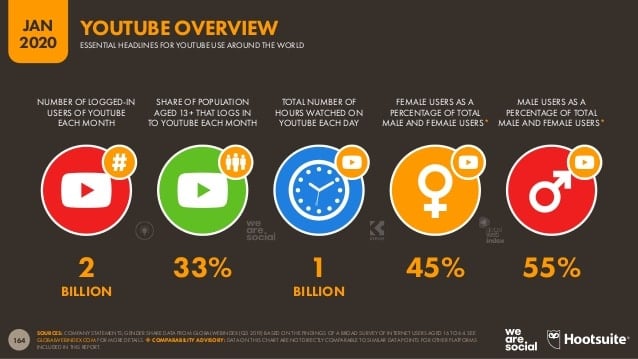
Source: Hootsuite Digital 2020
There are a few different video ad formats available on YouTube. Since Google owns YouTube, you'll need a Google AdWords account to create YouTube ads.
Skippable in-stream ads
These ads automatically play before, during, or after other videos on YouTube. They can also appear in other places in Google's display network, such as apps or games.
Users get the option to skip your ad after five seconds. The recommended video length is generally 30 seconds or less.
However, if you have a compelling story with great visuals, you can run longer.
Pro tip: Seventy-six percent of viewers skip ads by default. However, a skipped ad still increases the chances someone will visit or subscribe to your channel by 10 times. Make sure to get your most important messaging and branding in those unskippable first five seconds.

Source: Youtube
Non-Skippable YouTube ads
These are short ads that appear either at the start, mid-point, or end of a video. The ads are a maximum 15 seconds long, and they can't be skipped.
Pro tip: Just because users can't skip the ad doesn't mean they'll watch. Make sure your audio message is compelling in case they look away to do something else while your ad plays.
Video discovery ads
Video discovery ads appear next to related Youtube videos, in the results of a Youtube search, or on the mobile homepage.
The ads appear as a thumbnail image, with a little bit of text inviting users to click and watch.
For example, this saggy jowl thumbnail ad (rude) appeared on the side of this Trixie Mattel makeup review.
Pro tip: Consider that your thumbnail may be viewed at different sizes, and make sure that static image is clear (and enticing!) whether large or small.

Source: Youtube
Bumper Ads
These ads are also unskippable, but they're a maximum of six seconds long. They appear at the beginning, during, or end of YouTube videos.
Pro tip: Don't try to do too much in six seconds. Start with a strong visual, stick to one message, and leave enough time for your call to action.
Outstream ads
These mobile-only ads are not available on Youtube, and will only appear on websites and apps that run on Google video partners.
Outstream ads might run in web banners, or within apps as interstitials or in-feed content.
Pro tip: Outstream ads begin playing with the audio muted, so make sure your visuals can stand alone.
Masthead ads
This format really makes a splash, and is a great option for drumming up some publicity for a new product or service.
On the desktop, a masthead ad will autoplay a preview for up to 30 seconds at the top of the Youtube Home feed. It includes an info panel that pulls assets from your channel—here you can add up companion videos as well. When the autoplay stops, the video reverts to a thumbnail. Users can click through to watch the whole thing from your page.
On Mobile, Masthead ads play in full at the top of either the Youtube mobile site or the app. Here, you can customize the headline and description, as well as a call to action.
Pro tip: These ads are only available via reservation basis, so you'll need to contact a Google sales rep to learn more.

Source: Youtube
Get all the step-by-step instructions you need to set up your YouTube ads in our YouTube advertising guide.
TikTok ads
TikTok ads can help you work towards the following business goals:
- Traffic: Grow engagement with interactivity and creative content.
- Reach: Connect with diverse audiences across the world.
- Conversion: Encourage app installs and sales.
Audience considerations: A survey by the Global Web Index found that 60% of TikTok users fall into the 25-to-44 age bracket worldwide. But in the U.S., 69% of users are between 13 and 24 years old.
TikTok ads are only available in certain regions at this point in time, so depending on where you live, you might be stuck making organic content for now. But read on so that you'll be ready when the time comes.
Self-serve option: Images and videos
There's only one self-serve option for businesses on TikTok, and that's in-feed video. Whether you choose an image or a video, ads will appear in a user's "For You" feed. The ad will always be full-screen, just like user-generated content.
After the ad shows for nine seconds, a card appears with your brand's profile name and display name, plus text and a CTA button.
You can also choose to place ads across the parent company's other platforms (such as BuzzVideo and Babe), from within the TikTok Ad Manager.
Pro tip: The ads run fairly often, so TikTok suggests freshening up your creative every week at least to avoid ad fatigue.

Source: TikTok
Other TikTok ad types
Options like Brand Takeovers, Hashtag Challenges, Branded AR Content, and Custom Influencer packages are available with the help of an advertising rep.
At this point, it seems like anything is possible on TikTok, so reach out directly and see what you can do!
Get all the step-by-step instructions you need to set up your TikTok ads in our TikTok advertising guide.
There's a social media ad solution for every budget, from just a few dollars a day to million-dollar campaigns.
Ads on most social networks are sold in an auction format. You set a maximum bid for a target result (such as a click), or a maximum budget per day. There's no set amount to pay. As you create your ad, the ad manager interface will provide a recommended bid based on your stated goals.
You will generally pay using one of these methods, depending on your campaign goal:
- Cost per click (CPC)
- Cost per 1000 impressions (CPM)
- Cost per conversion
- Cost per video view
Several factors impact how much you will pay for a social media ad, beyond what your competitors are bidding. These factors include:
- The quality of your ad
- Your campaign objective
- Which type of audience you are targeting
- The country you're targeting
- Time of year, and even time of day
- Placement within the network.
For example, research by AdEspresso shows that the average Facebook CPC is $0.40 on Sundays, but nearly $0.50 on Tuesdays and Thursdays.
1. Know what business objective you're trying to achieve
It's no accident that we start each section of this guide by reviewing the business objectives each type of social media ads can help you achieve. It's awfully hard to achieve your goals if you don't know what your goals are in the first place.
Understanding your business objectives is critical. It ensures you choose the right social network to advertise on. It helps you choose the right advertising solution within that platform. It even guides your creative strategy.
2. Know your target audience
We've listed some audience considerations for each of the social networks. Keep in mind that they all offer quite specific ad targeting. Know exactly who you're trying to reach to take maximum advantage of these targeting options. This ensures you get the best bang for your advertising buck.
After all, there's no point in advertising to soccer moms in Florida if your audience is young male video gamers in New Jersey. The ability to micro-target your ad campaigns is one of the key benefits of social media advertising. Developing audience personas can help you understand exactly which audience segments to focus on.
3. Let your organic posts inform your ads
You're likely already posting content on Twitter, Facebook, and Instagram every day. Maybe LinkedIn and SnapChat, too.
Some of these posts will resonate with followers; others won't. Track which ones are being clicked, liked, shared, and commented on. These high-performing messages make the best candidates for social ads.
If you're branching out into a new network with your social media advertising, start small. Use what you've learned from your organic posts as a starting point. However, know that those lessons will not necessarily translate across social networks.
4. Pay for what matters: Impressions or engagement
To keep your budget under control, think about whether you want impressions or engagements.
If you're paying every time someone sees your ad (impressions), your message can cast a wide net.
But if you're paying for engagement, you only want people who are really interested in doing business with you to engage.
You don't want to pay for engagements that are not relevant to your business goals. The wording of your ad should help people identify whether it's for them or not.
Both engagement and impressions campaigns can be valuable for your business. You just need to choose the right one to align with your business goals so that you only pay for real business results.
Here's some more information about which metrics to track to make the most of your social ad campaign.
5. Design your ads with mobile in mind
More than 3.25 billion active social media users access social networks through a mobile device.
That means most social media ads are being viewed on mobile devices. Your mobile ads should be specifically designed for the small screen. Incorporate images that are easy to view on a pocket-sized device. (Unless, of course, you specifically choose desktop placement.)
If you have a bricks-and-mortar business, you can use "geofencing" to target mobile users when they are in a specific zip code. This means they only see your ads when they are close enough to walk in your front door.
6. Test your ads to optimize performance
One of the great benefits of social ads is instant feedback. You can gauge the effectiveness of a sponsored post in minutes and follow up with advanced analytics reports.
The best practice is to test several ads with small audiences to determine what works best, then use the winning ad in the primary campaign.
Testing one ad against another to determine what works best and refine your strategy is known as A/B testing. It's a critical part of your social media advertising efforts. We've got a full guide on how to do it right here: Social media A/B testing.
7. Measure results—and report on them
Just as it's important to know your goals before running an ad campaign, it's important to measure results. This will let you know whether you've hit your targets. It shows you what worked and what didn't so that you can improve going forward.
Measuring your results and having concrete data about the value your ads bring to the company (purchases, leads, and so on) is a key part of proving ROI.
And if you can prove that your ads are paying off, that will ensure you get the budget you need to continue your work.
The major social networks offer analytics to help you measure the results of ads. We've created in-depth guides on how to use them:
- Facebook analytics
- Instagram analytics
- Twitter analytics
- LinkedIn analytics
- Snapchat analytics
- Pinterest analytics
- Youtube analytics
- TikTok analytics
You can also use tools like Google Analytics and Hootsuite Impact to measure results across networks from a single dashboard. A social media report is a great way to track your results and look for great content to promote with social ads.
Prove (and improve) your social media advertising skills by taking Hootsuite Academy's industry-recognized Advanced Social Advertising course.
Get Certified
How To Set Up Paid Advertising On A Blog
Source: https://blog.hootsuite.com/social-media-advertising/
Posted by: cooperwrout1998.blogspot.com

0 Response to "How To Set Up Paid Advertising On A Blog"
Post a Comment